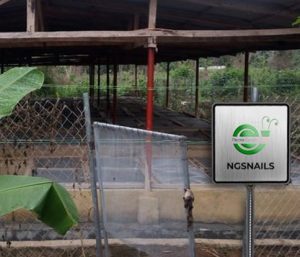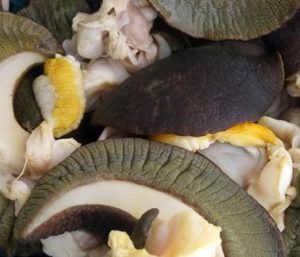Effective soil treatment process plays an important part in the size of your snail, which is why; snails will only thrive well in their natural environment or at least one similar to it. In simpler words, snails need a toxic-free soil to thrive
Now, are we saying it’s impossible to raise snails of large sizes on a snail farm? Of course not (you should see our snails). What we are saying is, for your snails to thrive, you have to create an environment, free from chemicals and harmful organisms to support their growth, and one way to do that is to treat your soil.
Here’s something you should always have in mind as a snail farmer, even when you give your snails a well-balanced feed, as long as they don’t have access to good soil, they will have fragile shells and other complications that will affect their growth.
Snails depend very much on good and well-treated soil as it provides them most of their calcium and water requirement, it provides them a safe spot to lay their eggs and rest during the dry season, and it also serves as a sanctuary against harmful organisms.
This is why you can’t afford to use just any soil on your farm.
What then is the ideal soil to use on your snail farm?
There are a lot of arguments around which type of soil is the most ideal for snail farming.
Here are some reasons why you shouldn’t use clay or sandy soil;
Clay soil becomes water-logged in the rainy season and compacts in the dry season, making it nearly impossible for your snails to dig into the soil. While sandy soil has a low water holding capacity – a sure way to deprive your snails of water and get them killed.
Some farmers opt for the sandy-loamy soil, which is good. But we’re a big fan of the Loamy Soil because it contains more decayed organic matter, which enhances the growth of the snails when ingested. Plus the loamy soil with its good water holding capacity has served as a comfort and thriving zone for our snails over the years, which is why we suggest you use it.
But it is not just enough to just get some loamy soil from a garden near you, put in your pen, and immediately introduce your snails to it (no, you shouldn’t do that) there are some characteristics you need to look out for in the loamy soil, such as;
The Soil Composition – this is the amount of mineral, water content, organic matter, gases, and microorganisms present in the soil (usually, the more the soil composition the better the loamy soil)
The Soil Texture – this is the percentage of sand, silt, and clay in the soil. The soil texture determines the rate at which water can enter the soil and how much it can absorb calcium, which is why the loamy soil must be loose.
The Soil Acidity – An acidic soil does not support the growth of snails. If a soil has been exposed to chemical substances such as insecticides, pesticides, or even some fertilizers, then the soil will harm your snails’ growth.
Well, those are the characteristics you need to look out for in the loamy soil.
But with the exception that you’re a soil expert, you might not be able to spot all these characteristics, so what do you do? It’s quite simple, once you see a loamy soil that supports the growth of tomatoes, cocoyam, and leafy vegetables, then you’ve hit gold! All you need to do now is to subject it to treatment because it might harbour some harmful organisms.
This leads us to…
READ ALSO: Snail Framing Business: Making Profit By Value Addition
4 Effective Soil Treatment Techniques To Support Snail Growth
The first is by subjecting the soil to heat
You can do this in three ways
- By Cooking: Cooking your soil comes off funny, right? Yeah, we know, but it has proven to be very effective in sterilizing the soil against insects that attack snails. Basically, all you do is pour the required soil in a pot, cover it up, and put it on fire for some minutes.
The heat will kill any insect hiding in the soil. You should also stir the soil with a stick to get the heat to every part of it.
Another way of subjecting the soil to heat is…
- By Sun Drying: For this, you need to spread your soil on a surface and expose it to the sun. The heat from the sun is enough to treat the soil, ensure the soil is well-spread to allow the heat from the sun penetrate to all the parts.
- Using Hot Water: Simply boil enough water, soak your soil in it for some minutes, drain the water, and your soil is as good as new.
Now after you must have subjected your soil to heat using any of the above processes, allow it cool before putting it in your snail pen, or better still, before introducing your snails to the pen.
After it has cooled, use a rake or a garden fork to remove dirt from the soil, and also to loosen it (just in case there’s any lump).
Now, add water, not so much that the pen gets water-logged, but enough to keep the soil moist. We suggest that you use a watering can or a nozzle shaped like a sprinkler, this is efficient in preventing you from “mistakenly” water-logging the soil. It is important you don’t add too much water to the soil because, apart from the fact that you might drown your snails, a water-logged soil is a breeding ground for “snail mites” – snail mites are tiny whitish insects that sting snails, making them lose appetite and eventually leading to their death.
The next step is to add calcium to the soil. This step is very crucial, yet most snail farmers don’t involve it when treating their soil (please don’t be like most farmers), snails depend more on the calcium in the soil to develop healthy shells. Some calcium sources include; eggshells, snail shells, oyster shells – well-grinded into a powdery form, and applied to the soil in the appropriate amount.
The above is how you effectively treat your soil using the method of subjecting it to heat.
Another method you can use in treating your soil is by…
Using the Neem Treatment
You probably might not have heard of this method of treatment, but for us at NGsnails, the neem treatment has kept the soil habitable for our snails. Now, as much as it comes off as a chemical form of treating the soil, we are glad to tell you it is purely organic.
You see at NGsnails, we understand that snails are bio-accumulators, and what they take in is what they give out. Basically, if they ingest any form of chemical from the soil, not only will it harm their growth, but if by some means they survive the effect, the meat gets contaminated, and our health is affected when we consume such meat. Which is why we only make use of organic processes on our farm.
Moving on, what is the Neem Treatment?
Neem is a key ingredient in non-pesticidal management, providing a natural alternative to synthetic pesticides. The treatment involves using the by-products of the neem tree (the seed in this case) to organically treat the soil. Neem seeds are crushed into powder, soaked overnight in water, and sprayed on the soil. The treatment only affects the harmful organisms in the soil and not the snails.
Note: Using the neem treatment requires some expertise because too much of it can be harmful to your snails’ growth.
Wrapping Up
The soil is a fertile medium for both harmful and harmless organisms to thrive in. Hence, it is essential you treat your soil to get rid of the harmful organisms, such as ants, bugs, centipedes, termites, etc. that will affect your snails’ growth or worse, get your snails killed if they are not eradicated on time.
But in a bid to eradicate these harmful organisms, please keep the soil treatment strictly organic. Using any form of chemical treatment will harm your snails.
Also, if you have snail pens that are small in sizes, ensure you change the soil in them every 2 to 3 months. Why? Harmful organisms accumulate faster in small spaces, plus unlike large pens where snails can avoid their slime trail, it’s almost impossible for them to do that in a small pen, and the pen becomes inhabitable for your snails when it gets concentrated with slime.
On a final note, dispose of any food remnants from your snail pens as soon as possible. Food remnants attract harmful organisms.
Now that you’ve learned something new as regards treating your soil to support the growth of your snails, kindly share this article with a snail farmer.
We wish you all the best as you practice organic farming.
REFERENCES
http://www.saferbrand.com/articles/benefits-uses-neem-oil-for-plants




